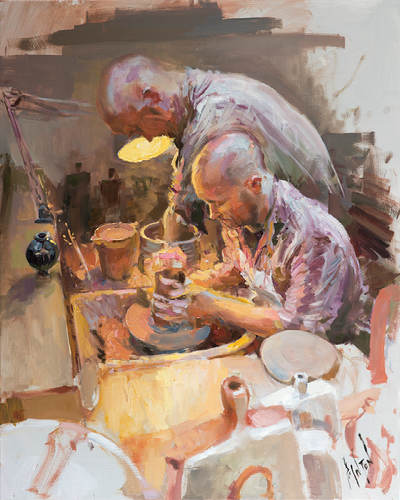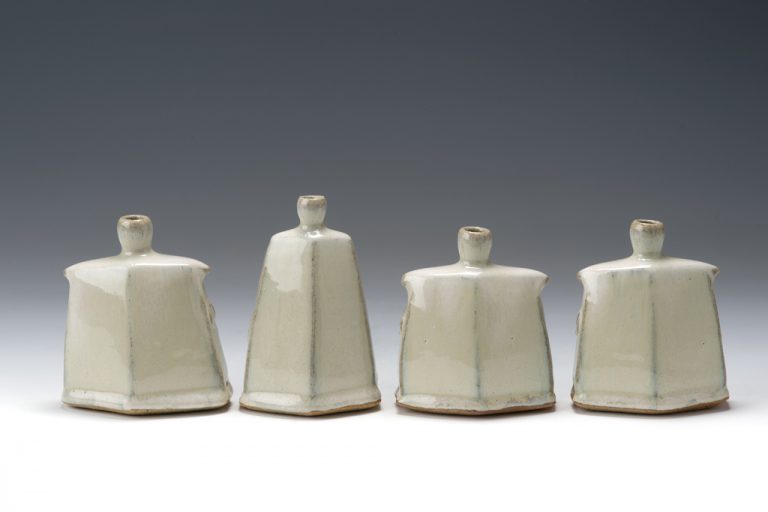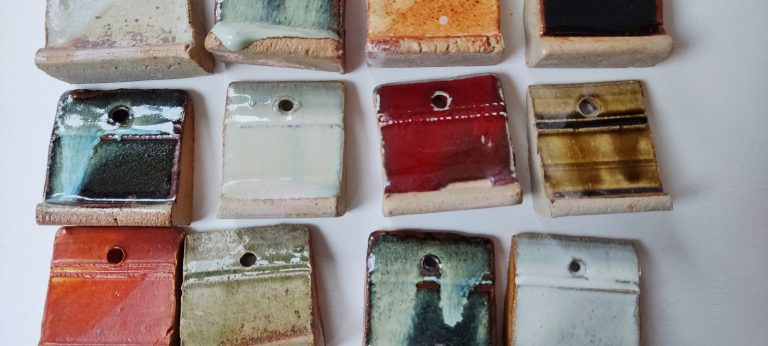Process
Making

After studying 3-Dimensional Design at Manchester Metropolitan University, James completed a Pottery Skills Course near Kilkenny in Ireland where the clear focus on technique – coupled with space and time – freed him to begin to discover his individual style.
The repetition, trial and error, necessary to become a technically able potter took the focus away from art and design, bringing his own instincts and preferences to the fore.
Drawing in the discipline of his early training, he now throws pots in groups exploring by making a series of similar forms which change slightly each time. This approach also filters into other areas of his making process – such as glazing and firing. He works by noticing and appreciating subtle differences and by discovering and learning as opposed to having an absolutely fixed goal.
These unexpected and interesting discoveries enable him to develop his work over time.
Incorporating the unexpected is the fuel that drives his work forward and draws him back to the process of making.
Ideas

Taking inspiration from Japanese ceramics, his work – which ranges from generously-proportioned chargers to palm-sized tealight holders – is also influenced by the sea-glazed sand and simplicity of Morecambe Bay near his home. Solitude and open landscapes have enabled him to forge his own way and make objects that feel both honest and unique.
His confident, distinctive style has been honed over years of ‘decision making’; the slow, instinctive process of working out what interests him as an artist, paring away the things that don’t matter.
Often his ideas originate from his response to the process of throwing at the wheel, using a slow wheel and soft clay to record the gestures of the hand. Recently he has been exploring making at the wheel in different ways. Making simple cylindrical forms then changing them into rectangular vases and squared flasks. Although rectangular, the final pieces retain the soft character which comes about by being formed at the wheel. These are then fired on their sides to allow glaze to run around their form, producing different glaze patterns on each side.
Whatever their design, James’s finished pieces all have a timeless quality, a pace or two removed from the influences of fast fashion, but always interesting and distinctively his own.
Glazing & Firing

Over the years James has developed a palette of his own glazes based on classic oriental glazes. These range from subtle Shinos, to rich, dark Tenmokus and Copper Reds. He is always adapting and experimenting , searching for different colours and textures. Each firing is an opportunity to try a few new glaze samples or adjustments.
James tries to keep the glazing as simple as possible to create a sense of movement, capturing the fluid nature of stoneware glaze. Glazes are applied quickly by dipping and pouring in simple combinations, which fuse together in the heat of the kiln. An enthusiast for sparseness and simplicity, each mark and decision is significant.
The final creative part of the making cycle is firing of the kiln. All of James’ work is ‘reduction fired’ to 1280 ᴼC in his large 80 cubic feet gas fired kiln. Typically, a firing will take around 16 – 18 hours followed by a natural cooling which can take up to four days. During key phases of the firing, oxygen is restricted into the chamber by slightly closing the flue at the top of the kiln, producing a ‘reducing atmosphere’. When this happens, flames appear at the spyholes and out of the flue of the kiln. James uses these inexact visual clues to judge the levels of reduction inside the kiln and identify the conditions likely to encourage the glaze effects he is searching for.
Like many other aspects of the making process, James has been exploring different ways of firing his work and learning by trial and error. Each piece in the kiln has as unique variation and nuance depending on its position in the kiln, the strength of reduction and the heat of the kiln. Exploring these variations is a constant source of intrigue and inspiration.
